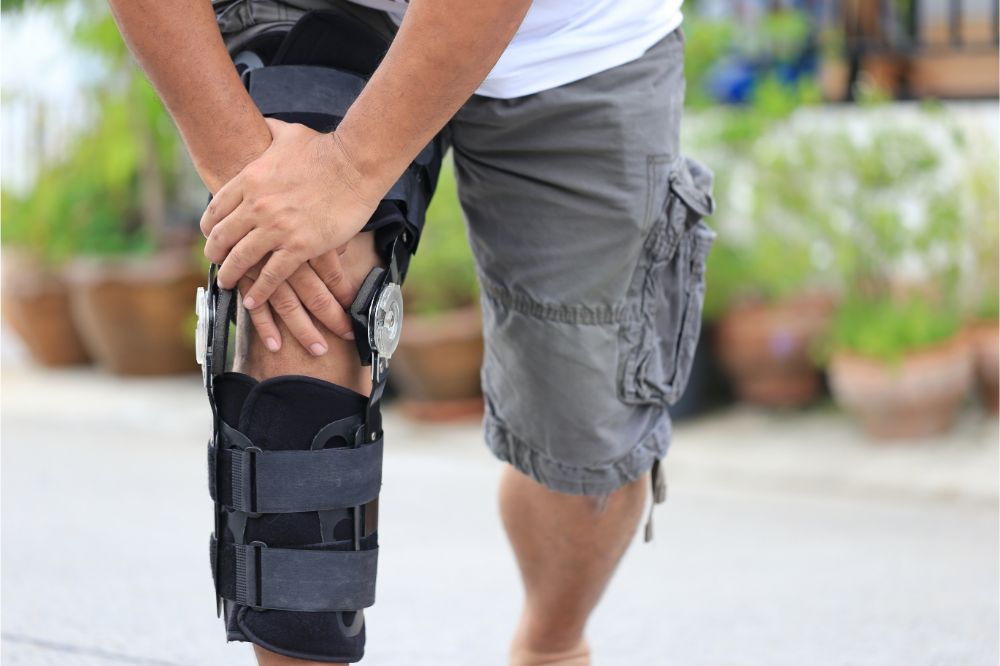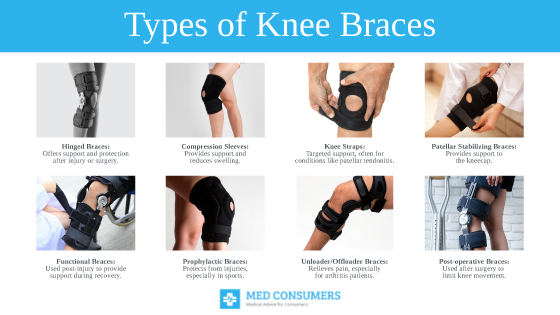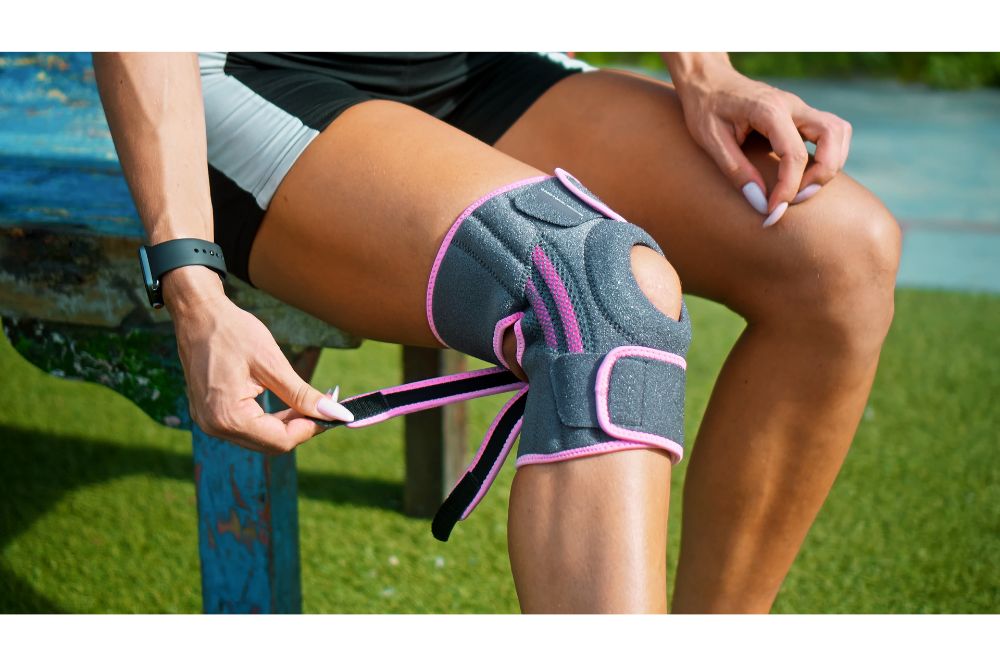Knee braces, not to be mistaken for the much stretchier knee sleeves, are a kind of knee support product that wraps around the knee area.
It is made of a stiffer material to support the knee during recovery from injuries and to prevent further complications.
While you probably have heard of and seen them before, how do knee braces work, really? The answer depends on the type of knee brace you have and the condition it is helping to treat.

What Is a Knee Brace?
While there are different kinds of knee braces, all of them offer support to the knees.
They come in various sizes and can be made using combinations of metal, foam, plastic, and other flexible materials.
That said, not all who experience knee pain need to wear knee braces.
You need to get in touch with your doctor so that he can assess your condition and determine whether you need one or not.
What Are the Different Types of Knee Supports?
For the uninformed, knee braces are often seen as a catch-all term for various kinds of knee support products.
In truth, a different kind of knee support may be needed depending on your needs or your diagnosis.

Knee Sleeves
Knee sleeves are the most common of the different types of knee supports. You will see them worn during exercise or by people suffering from knee discomfort.
Knee sleeves, like this pair from Bodyprox, use compression to reduce knee pain and swelling, improving how you move your knees.
It is made of an elastic material and used for treating minor injuries and for added support during intense physical activities like sports.
Functional Knee Braces
This variety of knee brace is one of the most used by athletes who, unsurprisingly, are more prone to knee injuries.
After they heal, they use functional braces to stabilize the movement of the knees and prevent another injury.
Rehabilitative Knee Braces
Rehabilitative knee braces are worn right after knee surgery to help with the movement of the damaged knee.
That said, not all doctors recommend using rehabilitative knee braces, especially early on in the recovery process.
Some would rather the knee fully heal first before introducing them to the patient.
Prophylactic Knee Braces
American football players often wear prophylactic knee braces to prevent injuries when playing the sport.
Although they haven’t been well-researched yet, many players believe they are effective.
Unloader Braces
The unloader type of knee brace is specifically made for people with osteoarthritis.
It transfers the weight or the movement of the unhealthy joint to the healthy joint to avoid further injuries to the knees.
Orthomen makes these specialized knee braces specifically for people with mild to moderate knee osteoarthritis, knee joint degeneration, and other common knee issues.
How Do Knee Braces Work?
Knee braces work depending on what they are designed for. They can function as a supportive device during injury recovery or lessen the risk of it.
However, they can only work if you follow your doctor’s advice on the type to get and how long to wear them.
A lot of knee braces use compression to support the muscles and ligaments so that the person can move freely without putting his full weight on the injured knee.
As the wearer puts their weight on that specific knee, the brace takes some of that weight off and restricts its range of motion to prevent strain.
As a result, they can still move freely while the knee joint is healing.
Other types of knee braces serve to seal heat into the recovering knee to improve blood circulation, reduce swelling, and speed up the healing process.
As you can imagine, this will be very helpful to those living in colder climates, as warmth positively impacts healing time.
When Are Knee Braces Helpful?
Even without an injury, you can wear knee supports to reduce the strain your knees experience, especially when working out or during intense athletic activity.
One of the most common joint problems requiring knee braces is osteoarthritis, a type of joint disease that swells the ligaments and tendons in your knees.
Another is the patellofemoral pain syndrome, also called runner’s knee. This injury is likely experienced by athletes who constantly use their lower bodies.
Patients who have this problem report experiencing pain in the kneecap.
An ACL (anterior cruciate ligament) injury frequently occurs in athletes who play sports that require running, jumping, and sudden changes in the direction of the legs.
An excellent example of a knee brace to wear for this type of injury is this one from Donjoy.
Like a torn ACL, another common knee injury is a torn meniscus.
The meniscus is the part of the knee joint that can get injured when a person accidentally twists their knee rapidly.

Dos and Don’ts When Wearing Knee Braces
To maximize knee braces’ effectiveness, you must make sure you know the dos and don’ts of wearing them.
Your doctor’s or physical therapist’s expert advice is the most crucial, but here are the basics to keep in mind:
Dos
- Especially when used to speed up injury recovery, always follow your healthcare provider’s instructions on how long to wear them in a day.
- Make sure you wear the appropriate type of knee brace according to your condition.
- If you were advised to wear them throughout the night, sleep flat on your back.
- Wear tight leggings if you want to wear your knee brace on top.
Don’ts
- Remember to take your prescribed pain meds if you’ll sleep with a knee brace on, which is not a problem.
- Those recovering from an injury should refrain from doing heavy exercises when wearing knee braces.
- Do not wear your post-op or functional knee brace over your pants, especially loose pairs; bending your leg will most definitely pull the brace down.
How To Choose the Right Knee Brace
Before anything else, you first need to know which type of knee brace to get.
Once you have that covered, you can go ahead and look at the many options available and how they differ.
For many, the most important thing about choosing a knee brace is finding one that offers the right amount of support without the extra bulk.
After all, if you only suffer from mild knee pain, you don’t really need a hinged knee brace that will restrict your movement.
Often, a soft knee brace or a simple knee sleeve will do.
Find the right balance between comfort and functionality so that your knee can heal correctly and you don’t have to stay glued to the couch during the process.
Knee Braces for Better Support
So how do knee braces work? In general, knee braces or knee supports work to promote and encourage healing and recovery.
They also offer support to the knees if you work out a lot or play plenty of physically-demanding sports.
As long as you wear the correct type of knee brace for your individual needs, it will help with your knee problems.
So, wear a compression sleeve if you have mild pain and some swelling, but get a hinged knee brace if you have more serious issues like knee arthritis.
Moreover, remember that wearing a knee brace is just one piece of the pie.
You also must consider additional treatment options like anti-inflammatory medications, physical therapy, balance training, stretching, and a good exercise plan.